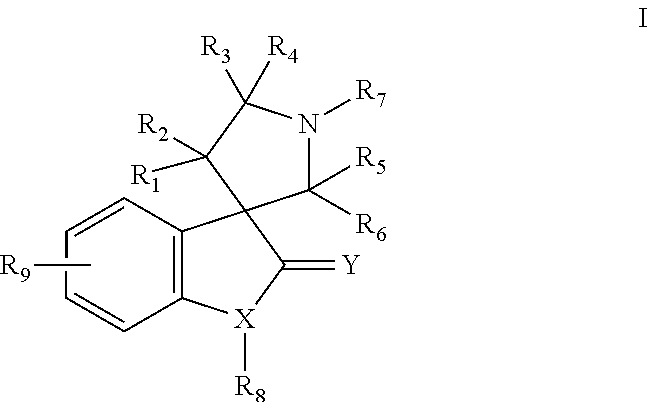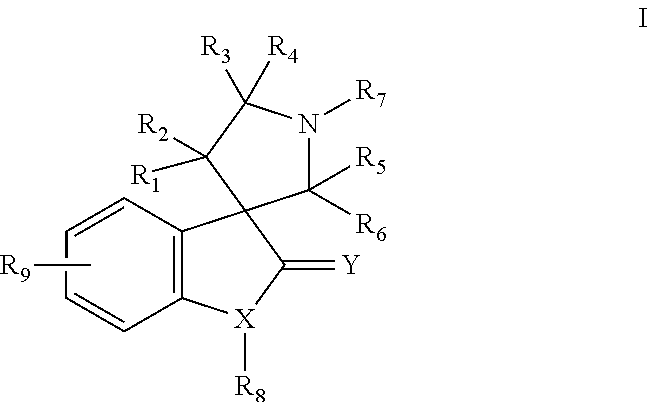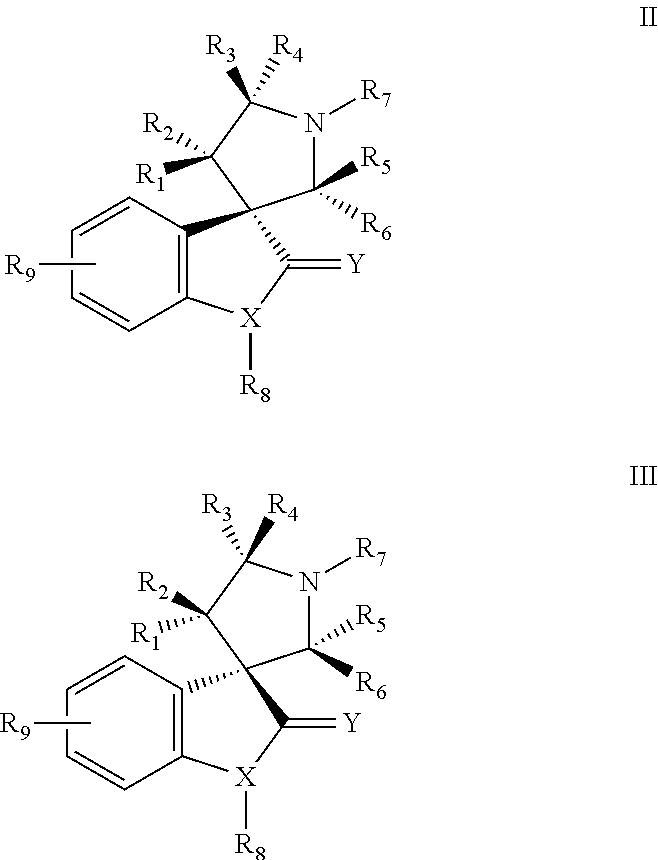Small molecule inhibitors of mdm2 and the uses thereof
a small molecule inhibitor and inhibitor technology, applied in the field of medicinal chemistry, can solve the problems of poor cell permeability and in vivo bioavailability, poor drug-like molecule inhibitors, and high throughput screening strategies that have had very limited success in identifying potent, non-peptide small molecule inhibitors
- Summary
- Abstract
- Description
- Claims
- Application Information
AI Technical Summary
Benefits of technology
Problems solved by technology
Method used
Image
Examples
example 1
6-CHLORO-4′-(3-CHLORO-PHENYL)-2′-(2,2-DIMETHYL-PROPYL)-5-FLUORO-2-OXO-1,2-DIHYDRO-SPIRO[INDOLE-3,3′-PYRROLIDINE]-5′-CARBOXYLIC ACID (3,4-DIHYDROXY-BUTYL)-AMIDE
1H NMR (300 MHz, CD3OH), δ 7.70 (d, 1H, J=8.4 Hz), 7.40-7.20 (m, 3H), 7.09 (m, 1H), 6.88 (d, 1H, J=6.0 Hz), 5.22 (d, 1H, J=11.4 Hz), 4.39 (m, 1H), 4.11 (d, 1H, J=11.1 Hz), 3.65-3.32 (m, 9H), 1.85 (m, 1H), 1.60 (m, 1H), 1.41 (m, 1H), 1.19 (m, 1H), 0.84 (s, 9H).
example 2
6-CHLORO-4′-(3-CHLORO-PHENYL)-2′-(2,2-DIMETHYL-PROPYL)-5-FLUORO-2-OXO-1,2-DIHYDRO-SPIRO[INDOLE-3,3′-PYRROLIDINE]-5′-CARBOXYLIC ACID (2,3-DIHYDROXY-PROPYL)-AMIDE
1H NMR (300 MHz, CD3OH), δ 7.74 (d, 1H, J=7.5 Hz), 7.35-7.15 (m, 3H), 7.11 (m, 1H), 6.88 (d, 1H, J=6.0 Hz), 5.22 (d, 1H, J=11.4 Hz), 4.33 (m, 1H), 4.28 (d, 1H, J=10.5 Hz), 3.67 (m, 2H), 3.65-3.32 (m, 4H), 2.05 (m, 1H), 1.90 (m, 1H), 1.56 (m, 1H), 0.87 (s, 9H).
example 3
6-CHLORO-4′-(3-CHLORO-PHENYL)-2′-(2,2-DIMETHYL-PROPYL)-5-FLUORO-2-OXO-1,2-DIHYDRO-SPIRO[INDOLE-3,3′-PYRROLIDINE]-5′-CARBOXYLIC ACID (3,5-DIHYDROXY-PENTYL)-AMIDE
1H NMR (300 MHz, CD3OH), δ 7.72 (d, 1H, J=8.4 Hz), 7.35-7.15 (m, 3H), 7.10 (m, 1H), 6.88 (d, 1H, J=6.0 Hz), 5.23 (d, 1H, J=11.1 Hz), 4.65 (m, 1H), 4.13 (d, 1H, J=11.4 Hz), 3.61 (m, 2H), 3.65-3.32 (m, 5H), 2.02 (m, 1H), 1.93 (m, 1H), 1.56 (m, 3H), 1.15 (m, 1H), 0.92 (s, 9H).
PUM
| Property | Measurement | Unit |
|---|---|---|
| resistance | aaaaa | aaaaa |
| cell permeability | aaaaa | aaaaa |
| crystal structure | aaaaa | aaaaa |
Abstract
Description
Claims
Application Information
 Login to View More
Login to View More - R&D
- Intellectual Property
- Life Sciences
- Materials
- Tech Scout
- Unparalleled Data Quality
- Higher Quality Content
- 60% Fewer Hallucinations
Browse by: Latest US Patents, China's latest patents, Technical Efficacy Thesaurus, Application Domain, Technology Topic, Popular Technical Reports.
© 2025 PatSnap. All rights reserved.Legal|Privacy policy|Modern Slavery Act Transparency Statement|Sitemap|About US| Contact US: help@patsnap.com



